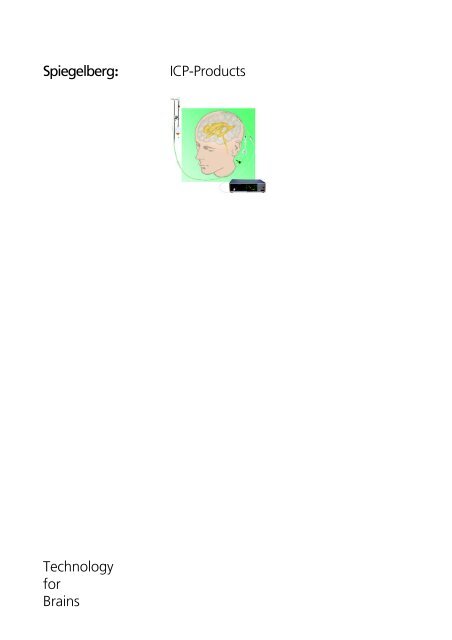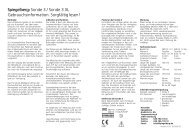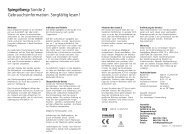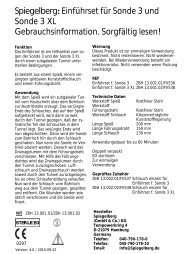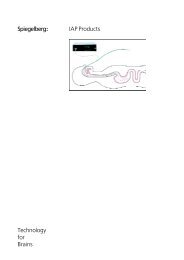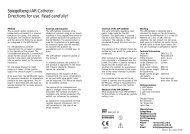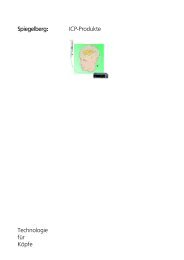ICP-Brochure - Spiegelberg
ICP-Brochure - Spiegelberg
ICP-Brochure - Spiegelberg
Create successful ePaper yourself
Turn your PDF publications into a flip-book with our unique Google optimized e-Paper software.
<strong>Spiegelberg</strong>: <strong>ICP</strong>-Products<br />
Technology<br />
for<br />
Brains
Contents<br />
<strong>ICP</strong>-Monitoring with the<br />
Air-Pouch System<br />
<strong>ICP</strong>-Monitors<br />
Epidural Probes<br />
Standard Intraventricular Probes<br />
Intraparenchymal Probes<br />
Intraventricular Probe with<br />
Temperature Sensor<br />
Antimicrobial Silverline<br />
Intraventricular Probes<br />
Scientific Information about Silverline<br />
Technology<br />
<strong>ICP</strong> Lab Software<br />
The Tunneling Tool<br />
The Pole Mount<br />
The Moore Drill<br />
Connecting Cables and Accessories<br />
3<br />
4<br />
5<br />
5<br />
6<br />
8<br />
9<br />
11<br />
12<br />
14<br />
14<br />
14<br />
15
<strong>ICP</strong> Monitoring<br />
With the Air-Pouch Method<br />
The Air-Pouch System consists of a<br />
hollow body connected to a pressure<br />
transducer by tubing. The pressure<br />
transducer, the electronic hardware,<br />
and the device for filling the Air-<br />
Pouch are integrated in the Brain-<br />
Pressure Monitor.<br />
For intraventricular or intraparenchymal<br />
pressure measurement the Air-<br />
Pouch is placed in the ventricle or in<br />
the parenchyma respectively. For epidural<br />
pressure measurement the Air-<br />
Pouch is placed on the dura of the patient.<br />
The Intracranial Pressure is transmitted<br />
across the thin pouch wall to the<br />
air volume in the pouch and transformed<br />
into an electric signal by the<br />
pressure transducer.<br />
On the digital display the mean pressure<br />
and the amplitude of the pressure<br />
wave are shown. At the monitor<br />
output the pulsatile signal is available.<br />
The <strong>ICP</strong>-Monitor can be connected to<br />
all ICU bedside monitors through their<br />
pressure transducer inputs.<br />
A voltage output allows the connection<br />
to chart recorders.<br />
Through the RS 232 interface a computer<br />
can be connected to read out<br />
the pressure signal.<br />
The <strong>ICP</strong>-Monitor zeroes automatically<br />
once per hour. This automatic in-vivo<br />
zeroing is a unique feature of the Air-<br />
Pouch system.<br />
The probes themselves do not contain<br />
electric or optic pressure transducers.<br />
That is the reason why they are very<br />
robust and not expensive.<br />
A complete line of intraventricular, intraparenchymal,<br />
subdural, and epidural<br />
probes is available.<br />
3
4<br />
<strong>ICP</strong> Monitors<br />
The Classic Choice with New Features<br />
The <strong>ICP</strong>-Monitor uses the Air-Pouch<br />
method for measuring intracranial<br />
pressure. It is compatible with the full<br />
range of Air-Pouch probes, with the<br />
CPP-Monitor and the Compliance-Monitor.<br />
The digital display indicates mean<br />
<strong>ICP</strong>, systolic <strong>ICP</strong> and diastolic <strong>ICP</strong>. Additionally<br />
a mains power control light<br />
is visible.<br />
Two connectors in the back of the<br />
monitor take a connecting cable to a<br />
bedside monitor or chart recorder<br />
and a connecting cable to a CPP-Monitor,<br />
a Compliance-Monitor or a<br />
computer.<br />
The stainless steel enclosure is resistant<br />
to wear and tear and to influences<br />
from the environment.<br />
The <strong>ICP</strong>-Monitor with Batteries<br />
The new <strong>ICP</strong>-Monitor has all the features<br />
of the classic choice. Additionally<br />
it is equipped with rechargeable<br />
batteries that allow more than three<br />
hours of independent operation. It is<br />
compatible with the full range of Air-<br />
Pouch probes, with the CPP-Monitor<br />
and the Compliance-Monitor.<br />
The digital display indicates mean<br />
<strong>ICP</strong>, systolic <strong>ICP</strong> and diastolic <strong>ICP</strong>. Additionally<br />
a charge control light and a<br />
battery state indicator are visible.<br />
Two connectors in the back of the<br />
monitor take a connecting cable to a<br />
bedside monitor or chart recorder<br />
and a connecting cable to a CPP-Monitor,<br />
a Compliance-Monitor or a<br />
computer.<br />
The stainless steel enclosure is resistant<br />
to wear and tear and to influences<br />
from the environment.<br />
Description REF<br />
<strong>ICP</strong>-Monitor 230 V HDM 26.1/FV500<br />
<strong>ICP</strong>-Monitor 115 V HDM 26.1/FV503<br />
Technical Information<br />
Measurement range -50 to +100 mmHg<br />
Displays Mean <strong>ICP</strong><br />
Systolic <strong>ICP</strong><br />
Diastolic <strong>ICP</strong><br />
Mains control<br />
Voltage output 1 V/50 mmHg<br />
Pressure monitor 5 µV/mmHg/V<br />
output<br />
RS 232 C interface 9600 Bd<br />
Accuracy class 2<br />
Safety class I, type BF<br />
Description REF<br />
<strong>ICP</strong>-Monitor with Batteries HDM 29.1<br />
(indicate voltage)<br />
Technical Information<br />
Measurement range -50 to +100 mmHg<br />
Displays Mean <strong>ICP</strong><br />
Systolic <strong>ICP</strong><br />
Diastolic <strong>ICP</strong><br />
Battery state<br />
Charge control<br />
Running time More than 3 h<br />
on batteries<br />
Voltage output 1 V/50 mmHg<br />
Pressure monitor 5 µV/mmHg/V<br />
output<br />
RS 232 C interface 9600 Bd<br />
Accuracy class 2<br />
Safety class I, type BF
Epidural Probes<br />
Probe 1<br />
Probe 1 is placed concentrically on<br />
the dura. It is used when intracranial<br />
pressure monitoring with minimum<br />
risk of infection is desired.<br />
A burr hole of 11 mm diameter is required.<br />
In adults this can be drilled<br />
with a standard trepan. For thin skull<br />
caps the use of a Martell Drill or hand<br />
drill is recommended.<br />
Probe 2<br />
Probe 2 is to be used postoperatively<br />
after large trepanation. It is placed<br />
under the bone flap.<br />
In principle, after mobilisation of a<br />
sufficiently large area of the dura, the<br />
probe can be inserted between the<br />
dura and the cranial bone through a<br />
burr hole.<br />
Standard Intraventricular Probes<br />
Probe 3<br />
Probe 3 measures intraventricular<br />
pressure using an Air-Pouch mounted<br />
in the tip region of a dual lumen<br />
probe. One lumen transmits the<br />
pressure to the Brain-Pressure<br />
Monitor. The second lumen is used<br />
for drainage of CSF. The measurement<br />
of pressure in the parenchyma<br />
is also possible. There is no interference<br />
of drainage and pressure<br />
measurement.<br />
As opposed to measurements via CSF<br />
coupled pressure transducers, <strong>ICP</strong> is<br />
still transmitted in the case of slit ventricles.<br />
Description REF<br />
Probe 1 SND 13.1.11/FV530<br />
Technical Information<br />
Material Polyurethane<br />
Filling volume .05 - .1 cc<br />
Outer diameter 2 mm<br />
Length 1500 mm<br />
Air-Pouch diameter 16 mm<br />
Burr Hole diameter 11 mm<br />
Duration of use Short term<br />
not more than 30<br />
days<br />
Shelf life 3 years<br />
Double packed<br />
EO sterile<br />
For single use<br />
Latex free<br />
Description REF<br />
Probe 2 SND 13.1.12/FV531<br />
Technical Information<br />
Material Polyurethane<br />
Filling volume .05 - .1 cc<br />
Outer diameter 2 mm<br />
Length 1500 mm<br />
Air-Pouch width 11 mm<br />
Air-Pouch length 25 mm<br />
Duration of use Short term<br />
not more than 30<br />
days<br />
Shelf life 3 years<br />
Double packed<br />
EO sterile<br />
For single use<br />
Latex free<br />
Description REF<br />
Probe 3 SND 13.1.13/FV532<br />
Technical Information<br />
Material Polyurethane<br />
Filling volume .05 - .1 cc<br />
Outside diameter 2.3 mm<br />
Inside diameter drainage 1 mm<br />
Dual lumen length 130 mm<br />
with radiopaque stripe<br />
Single lumen length 150 mm<br />
(Drainage)<br />
Single lumen length 1370 mm<br />
(Air-System)<br />
Depth marks 50 - 100 mm<br />
Duration of use Short term<br />
not more than 30<br />
days<br />
Shelf life 3 years<br />
Double packed<br />
EO sterile<br />
For single use<br />
Latex free<br />
5
6<br />
Probe 3 XL<br />
Probe 3 XL has all the properties of<br />
Probe 3. Furthermore, it is equipped<br />
with a wider drainage lumen for use<br />
with blood in the CSF.<br />
Intraparenchymal Probes<br />
Probe 3 PN<br />
Probe 3 PN measures intraparenchymal<br />
pressure.<br />
Probe 3 PN is placed in the parenchyma<br />
through a burr hole. Probe 3<br />
PN can be tunneled with the aid of<br />
the tunneling tool ZBH 13.001.03.<br />
Probe 3 PN is fixed to the skin with a<br />
suturing flap.<br />
Probe 3 PS<br />
Probe 3 PS measures intraparenchymal<br />
pressure.<br />
Probe 3 PS is placed in the parenchyma<br />
through a bolt that is screwed<br />
into the cranial bone. A compressionscrew<br />
connection fixes the probe in<br />
the bolt and tightens it.<br />
Description REF<br />
Probe 3 XL SND 13.1.13XL/FV533<br />
Technical Information<br />
Material Polyurethane<br />
Filling volume .05 - .1 cc<br />
Outside diameter 3 mm<br />
Inside diameter for 1.6 mm<br />
Drainage<br />
Dual lumen length 130 mm<br />
with radiopaque stripe<br />
Single lumen length 150 mm<br />
(Drainage)<br />
Single lumen length 1370 mm<br />
(Air-System)<br />
Depth marks 50 - 100 mm<br />
Duration of use Short term<br />
not more than 30<br />
days<br />
Shelf life 3 years<br />
Double packed<br />
EO sterile<br />
For single use<br />
Latex free<br />
Description REF<br />
Probe 3 PN SND 13.1.53/FV534<br />
Technical Information<br />
Material Polyurethane<br />
Filling volume .05 - .1 cc<br />
Diameter 1.3 mm<br />
Length 1500 mm<br />
Air Tube radiopaque<br />
Depth marks 30 mm<br />
40 mm<br />
Duration of use Short term<br />
not more than 30<br />
days<br />
Shelf life 3 years<br />
Double packed<br />
EO sterile<br />
For single use<br />
Latex free<br />
Description REF<br />
Probe 3 PS SND 13.1.63/FV535<br />
Technical Information<br />
Material Polyurethane<br />
Filling volume .05 - .1 cc<br />
Diameter 1.3 mm<br />
Length 1500 mm<br />
Air Tube radiopaque<br />
Duration of use Short term<br />
not more than 30<br />
days<br />
Shelf life 3 years<br />
Double packed<br />
EO sterile<br />
For single use<br />
Latex free
Probe 3 PN with Trocar<br />
The trocar is used to<br />
tunnel the distal end of<br />
the probe. It is<br />
equipped with a conic<br />
hole to take up the<br />
connector of the airtube<br />
.<br />
The probe has two<br />
depth marks.<br />
Probe 3 PN with trocar measures<br />
intraparenchymal pressure.<br />
The probe is placed in the parenchyma<br />
through a burr hole.<br />
Probe 3 PN with trocar is tunneled by<br />
means of the trocar in a surgically<br />
correct fashion away from the burr<br />
hole. To facilitate the tunneling, the<br />
air tube is equipped with a<br />
connector, that is taken up by the<br />
trocar.<br />
The extension is used to<br />
connect the probe with<br />
the <strong>ICP</strong>-Monitor.<br />
The slitted suturing wing<br />
is used for the fixation to<br />
the skin.<br />
After tunneling, the trocar is removed<br />
and the air tube is connected to the<br />
<strong>ICP</strong>-Monitor by means of the<br />
extension.<br />
Probe 3 PN is fixed to the skin with a<br />
suturing wing.<br />
The nut secures the<br />
connection of the probe<br />
to the extension.<br />
Description REF<br />
Probe 3 PN with Trocar SND 13.1.54<br />
Technical Information<br />
Material Polyurethane<br />
Filling volume .05 - .1 cc<br />
Diameter 1.3 mm<br />
Length 1500 mm<br />
Air Tube radiopaque<br />
Depth marks 30 mm<br />
40 mm<br />
Duration of use Short term<br />
not more than 30<br />
days<br />
Shelf life 3 years<br />
Double packed<br />
EO sterile<br />
For single use<br />
Latex free<br />
7
8<br />
Intraventricular Probe with Temperature Sensor<br />
In the tip of the probe a<br />
temperature sensor is<br />
located.<br />
The probe is outfitted<br />
with lettered marks.<br />
The Probe 3 XLT measures<br />
intraventricular pressure with an airpouch<br />
mounted in the tip region of a<br />
dual lumen probe. One lumen<br />
transmits the pressure to the Brain-<br />
Pressure Monitor. The second lumen<br />
is used for drainage of CSF. The<br />
measurement of pressure in the<br />
parenchyma is also possible. There is<br />
no interference of drainage and<br />
pressure measurement.<br />
As opposed to measurements via<br />
CSF coupled pressure transducers,<br />
<strong>ICP</strong> is still transmitted in the case of<br />
slit ventricles.<br />
Additionally a temperature sensor is<br />
located in the tip of the probe.<br />
Through an adapter cable the probe<br />
is connected directly to the<br />
temperature input of a patient<br />
monitor.<br />
The slotted suture<br />
clamp is used for<br />
fixation to the skin.<br />
Description REF<br />
Probe 3 XLT SND 13.1.13 XLT<br />
Technical Information<br />
The air tube connects<br />
the probe with the <strong>ICP</strong>-<br />
Monitor.<br />
The stylet is used for<br />
stiffening during<br />
insertion.<br />
Material Polyurethane<br />
Filling volume .05 - .1 ml<br />
Outer diameter 3 mm<br />
Inner diameter of 1.6 mm<br />
drainage lumen<br />
Length of dual lumen 130 mm<br />
part with radiopaque<br />
stripe<br />
Length of single lumen 150 mm<br />
part (drainage)<br />
Length of single lumen 1370 mm<br />
part (air system)<br />
Depth marks 50 - 100 mm<br />
Sensitivity of YSI 400<br />
temperature sensor<br />
Duration of use Short term,<br />
not more than 30 days<br />
Shelf life 3 years<br />
Double packed<br />
EO sterile<br />
For single use<br />
Latex free<br />
Adapter Cables for<br />
Temperature Input<br />
of Patient Monitor<br />
Description REF<br />
The adapter cable<br />
connects the probe to<br />
the patient monitor.<br />
The Luer-Lock connector<br />
connects the probe to<br />
the EVD kit.<br />
Adapter Cable with KBL 13.040.01<br />
6.35 mm Audio Plug<br />
Adapter Cable with KBL 13.041.01<br />
Draeger Connector<br />
Adapter Cable with KBL 13.043.01<br />
Philips/HP Connector
Tunnelable Antimicrobial Intraventricular Probe<br />
The dual trocar is used<br />
to tunnelate the distal<br />
end of the probe. It is<br />
equipped with a conic<br />
hole to take up the<br />
connector of the air-tube<br />
and a saw toothed<br />
connector to take up the<br />
drainage tube.<br />
The air-pouch is 35%<br />
smaller than the one on<br />
standard ventricular<br />
probes.<br />
Silverline ventricular probes are<br />
tunneled by means of the dual trocar<br />
in a surgically correct fashion away<br />
from the burr hole. To facilitate the<br />
tunneling, the air tube is equipped<br />
with a connector, that is taken up by<br />
the trocar together with the drainage<br />
tube. After tunneling, the trocar is<br />
removed and the air tube is<br />
connected to the <strong>ICP</strong>-Monitor by<br />
means of the extension. The drainage<br />
tube is connected to a drainage kit<br />
with the Luer connector.<br />
The catheter has<br />
numbered depth marks.<br />
The extension is used to<br />
connect the probe with<br />
the <strong>ICP</strong>-Monitor.<br />
The slitted suturing wing<br />
is used for the fixation to<br />
the skin.<br />
The air-pouch of the Silverline<br />
ventricular probes is 35% smaller<br />
than that of the standard ventricular<br />
probes. The tip of the probe is<br />
equipped with four rows of drainage<br />
holes, just like a ventricular catheter.<br />
The Luer-Lock<br />
Connector adapts the<br />
catheter to the EVD kit.<br />
Description Antimicrobial Antimicrobial<br />
Intraventricular Intraventricular<br />
Probe 8F Probe 10F<br />
REF SND 13.1.14 SND 13.1.15<br />
Technical Information<br />
Material Silver bearing Silver bearing<br />
polyurethane polyurethane<br />
Filling volume .05 - .1 ml .05 - .1 ml<br />
Outer diameter 2.7 mm 3.3 mm<br />
Inner diameter drainage 1.5 mm 2 mm<br />
Length of dual-lumen 200 mm 200 mm<br />
probe<br />
Length of single lumen 70 mm 70 mm<br />
drainage tube<br />
Length of single lumen 95 mm 95 mm<br />
air tube<br />
Length of extension 1200 mm 1200 mm<br />
tube<br />
Depth marks 50 - 100 mm 50 - 100 mm<br />
150 mm 150 mm<br />
Duration of use short term,<br />
not more than 30 days<br />
Shelf life 3 years<br />
Double packed<br />
For single use<br />
EO sterile<br />
Latex free<br />
The nut secures the<br />
connection of the probe<br />
to the extension.<br />
The stylet is used to<br />
introduce the catheter<br />
into the ventricle.<br />
9
10<br />
Antimicrobial Intraventricular Probe with Bolt<br />
The air-pouch is 35%<br />
smaller than the one on<br />
standard ventricular<br />
probes.<br />
The probe has two sets<br />
of numbered depth<br />
marks. The first set is<br />
related to the tip of the<br />
probe.<br />
The drill bit has an<br />
adjustable stop.<br />
The Allen wrench is<br />
used to adjust the stop.<br />
The dura opener is used<br />
to perforate the dura<br />
mater.<br />
The Silverline ventricular probe with<br />
bolt is fixed in the bone by means of<br />
a bolt. After making a burr hole and<br />
opening the dura the probe is placed<br />
in the ventricle with the bolt in place<br />
in the upper region of the probe.<br />
Then the bolt is slid down to the burr<br />
hole and screwed into the bone.<br />
Finally the probe is fixed in the bolt<br />
with the clamping nut. The Luerconnector<br />
is placed in the drainage<br />
tube and connected to a drainage<br />
kit. The air tube is connected to the<br />
<strong>ICP</strong>-Monitor.<br />
With the clamping nut<br />
the probe is fixed in the<br />
bolt.<br />
The second set of depth<br />
marks is related to the<br />
upper edge of the bolt.<br />
Description REF<br />
Antimicrobial SND 13.1.14 S<br />
Intraventricular Probe<br />
with Bolt 8F<br />
Technical Information<br />
The stylet is used to<br />
introduce the probe<br />
into the ventricle.<br />
The Luer-Lock<br />
Connector adapts the<br />
probe to the EVD kit.<br />
Material Silverimpregnated<br />
Polyurethane<br />
Filling volume .05 - .1 ml<br />
Outer diameter 2.7 mm<br />
Inner diameter drainage 1.5 mm<br />
Length of dual-lumen 200 mm<br />
probe<br />
Length of single lumen 1300 mm<br />
air tube<br />
Length of single lumen 70 mm<br />
drainage tube<br />
depth marks 50 mm<br />
60 mm<br />
70 mm<br />
Duration of use short term,<br />
not more than 30 days<br />
Shelf life 3 years<br />
Double packed<br />
EO sterile<br />
For single use<br />
Latex-free
Scientific Information about Silverline ® Technology<br />
Silverline Ventricular Probes are used<br />
for drainage and <strong>ICP</strong>-monitoring at<br />
the same time. They are made of<br />
polyurethane. Particles of silver and<br />
particles of an an unsoluble silver<br />
salt are incorporated in the material.<br />
Silver ions have a strong antiseptic<br />
effect. Because of the small size of<br />
the particles the specific surface area<br />
is large, which results in the release<br />
of ions in antimicrobial concentration<br />
on the surface of the catheter.<br />
The combination of the fast acting<br />
silver salt and the slow acting metallic<br />
silver results in an optimal short<br />
term and long term effect. The silver<br />
salt starts to release silver ions<br />
immediately when it gets in contact<br />
with body fluid. The release of silver<br />
ions from the metallic silver particles<br />
doesn´t start until some hours later,<br />
when the effect of the silver salt<br />
slows down.<br />
Silverline ventricular probes are<br />
available in two styles and in two<br />
diameters.<br />
In an in-vitro study (7) the Silverline<br />
material could demonstrate an<br />
antimicrobial effect on:<br />
- Staph. aureus,<br />
- Staph. epidermidis,<br />
- multi resistant Staph.,<br />
- E. coli,<br />
- Pseudomonas aeruginosa,<br />
- Clostridium difficile,<br />
- Acinetobacter baumannii,<br />
- Streptococcus intermedius,<br />
- Candida albicans, and<br />
- Candida glabrata.<br />
Clinical studies indicate a marked<br />
reduction of the infection rate<br />
(9,10,11).<br />
Bibliography<br />
1. Anneke, A.: Infektiöse Komplikationen<br />
von Liquoraußendrainagen.<br />
Dissertation Universität<br />
Heidelberg, 1999<br />
2. Lozier AP, Sciacca RR, Romagnoli<br />
MF, Connolly ES Ventriculostomyrelated<br />
infections: A critical<br />
review of literature. Neurosurgery<br />
51, 2002, 170-182<br />
3. Naegeli, C. v.:Über die<br />
oligodynamischen Erscheinungen<br />
an lebenden Zellen. Neue<br />
Denkschr. Allg. Schweiz. Ges.<br />
0 h 16 h 32 h<br />
Cultures of catheters after subjecting them to a suspension of Staph. aureus<br />
Upper row: Silverline catheter<br />
Lower row: Control catheter<br />
Naturwiss. 33, 1893, 174 - 182<br />
4. Pfisterer, W.;Mühlbauer, M.;<br />
Czech, T.; Reinprecht, A.: Early<br />
diagnosis of external ventricular<br />
drainage infection: results of a<br />
prospective study. J Neurol<br />
Neurosurg Psychiatry 74, 2003,<br />
929–932<br />
5. Thurmann, R.B.; Gerba, C.H.P.:<br />
The molecular mechanisms of<br />
copper and silver ion disinfection<br />
of bacteria and viruses. Crit. Rev.<br />
Environmental Control, 18, 1989,<br />
295-315<br />
6. Zabramski J.M.; Darouiche, R.O.<br />
et al.: Efficacy of antimicrobialimpregnated<br />
external ventricular<br />
catheters: a prospective,<br />
randomized, controlled trial. J<br />
Neurosurg, 98, 2003, 725-730<br />
7. Zschaler, R.: Testing of the<br />
Antimicrobial Effect of Catheter<br />
Tubing with a Roll Culture<br />
Method. www.spiegelberg.de/<br />
home/documents/Zschaler.pdf<br />
8. Kojic, E.M.; Darouiche, R.O.: Candida<br />
infections of medical<br />
devices. Clin. Microbiol. Rev., 17,<br />
2004, 255-267<br />
9. Keong, N.C.;D. Bulters, H.<br />
Richards, M. Farrington, O.<br />
Sparrow, J.D. Pickard, P.J.<br />
Hutchinson, P.J. Kirkpatrick: The<br />
SILVER (Silver-Impregnated Line Vs<br />
EVD Randomized) Trial : A Double-blind,<br />
Prospective, Randomized<br />
Controlled Trial of an Intervention<br />
to Reduce the Rate of External<br />
Ventricular Drain Infection.<br />
Neurosurgery, 71(2):394-404, August<br />
2012<br />
11. Izci, Y.; Secer, H.; Akay, C.;<br />
Gonul, E.: Initial experience with<br />
silver-impregnated polyurethane<br />
ventricular catheter for shunting<br />
of cerebrospinal fluid in patients<br />
with infected hydrocephalus.<br />
Neurol. Res. 2008, online version.<br />
12. Fichtner, J.; Güresir, E.; Seifert, V.;<br />
Raabe, A.: Efficacy of silverbearing<br />
external ventricular<br />
drainage catheters: a retrospective<br />
analysis. J Neurosurg, Sept.<br />
18, 2009, DOI: 10.3171/<br />
2009.8.JNS091297<br />
11
12<br />
<strong>Spiegelberg</strong>: <strong>ICP</strong> Lab<br />
Software for<br />
<strong>ICP</strong> Data Processing<br />
Up to five pressure<br />
channels can be shown<br />
simultaneously.<br />
Individual pressure<br />
scales can be chosen<br />
for the different<br />
channels.<br />
Data Capture<br />
The <strong>ICP</strong> Lab software has been<br />
written to allow data capture from<br />
the <strong>Spiegelberg</strong> <strong>ICP</strong>-Monitor, CPP-<br />
Monitor, and Compliance-Monitor<br />
(CMP) using RS 232 connection and<br />
a Windows XP (or above) computer.<br />
<strong>ICP</strong> Lab captures up to five signals<br />
simultaneously:<br />
- <strong>ICP</strong><br />
- ABP<br />
- CPP<br />
- Compliance<br />
- PVI<br />
Tools and procedures<br />
are available for data<br />
collection and<br />
processing.<br />
Individual time scales<br />
can be chosen.<br />
Sampling Frequency<br />
The data collection can be made<br />
with sampling frequency of up to 100<br />
Hz. The data is then stored in a file<br />
using ICM+ software raw signals<br />
format ‘.dta’.<br />
Browsing<br />
The <strong>ICP</strong> Lab software contains some<br />
basic tools for signal browsing. The<br />
time scale and pressure scale can be<br />
chosen individually. Printing of<br />
selected time intervalls can be<br />
performed in black and white or full<br />
color on any of the standard printers<br />
of your computer.<br />
Advanced Analysis<br />
For more advanced analysis the data<br />
can be exported to a text file and<br />
then imported to a spreadsheet<br />
application like Excel.<br />
However, for best results it should be<br />
analysed using specialised software<br />
for <strong>ICP</strong> waveforms analysis like<br />
ICM+.
Trial Version<br />
The software will work for one<br />
month. After the trial period, you will<br />
need to register the software. To<br />
register you will need to obtain a<br />
license from your distributor. With<br />
the license you will get a license<br />
number.<br />
Getting a Key<br />
Once you have obtained your license,<br />
please follow the instructions in the<br />
Help/Register pull down menu of <strong>ICP</strong><br />
Lab. An install code will be indicated<br />
in the menu. Upon sending the<br />
install code with your license number<br />
to us by email or entering the install<br />
code online, you will get the key by<br />
email within seven days.<br />
Registration<br />
Entering the key and filling in the<br />
required fields in the menu will result<br />
in a permanently operational program.<br />
Written by<br />
Dr. Peter Smielewski<br />
Department of Clinical Neurosciences<br />
University of Cambridge, UK<br />
Copy Protection<br />
The program is copy protected. It will<br />
be operational only on one<br />
computer. If your computer is<br />
damaged or otherwise unusable,<br />
please notify us. We will then issue<br />
a new key for your new computer.<br />
Serial communication<br />
<strong>ICP</strong> Lab works with all <strong>Spiegelberg</strong><br />
Brain-Pressure monitors, <strong>ICP</strong>-Monitors,<br />
CPP-Monitors, and Compliance-<br />
Monitors. Communication is done<br />
through an RS 232 interface. If your<br />
computer is equipped with an RS 232<br />
interface, then you will have to select<br />
the COM port associated with the<br />
interface in the Setup menu of <strong>ICP</strong><br />
Lab.<br />
If your computer does not have an RS<br />
232 interface, you will first need to<br />
install a USB to RS 232 converter.<br />
Follow the instructions of your USB to<br />
RS 232 converter for installation.<br />
Once the converter is installed, you<br />
will need to select the COM port in<br />
the Setup menu.<br />
Compatibility<br />
<strong>ICP</strong> Lab uses the same data format as<br />
ICM+. It is fully upward compatible. All<br />
data files created with <strong>ICP</strong> Lab can be<br />
later analyzed by ICM+.<br />
Description REF<br />
<strong>ICP</strong> Lab CD LAB 08.001.01<br />
<strong>ICP</strong> Lab License LAB 08.002.01<br />
Technical Information<br />
Compatible with HDM 13.x<br />
HDM 26.x<br />
HDM 29.x<br />
CPP 21.x<br />
CMP 27.x<br />
Communication RS 232, 9600 Bd, 8 bits<br />
1 stop bit, no parity<br />
System requirements Windows XP or above<br />
Features Recording<br />
Storing<br />
Browsing<br />
Printing<br />
Compatible Connecting Cables<br />
Description REF<br />
RS 232 cable, 9 pin, KBL 13.033.01<br />
25 cm long<br />
RS 232 cable, 9 pin, KBL 13.033.00/FV656<br />
1.5 m long<br />
USB/RS 232 Cable Kit KBL13.036.01<br />
Consisting of Computer<br />
Cable RS 232, 25 cm and<br />
USB/RS 232 Converter<br />
13
14<br />
The Tunneling Tool<br />
The Tunneling Tool is an accessory<br />
for the sterile placement of Probe 3,<br />
Probe 3 XL, and Probe 3 PN.<br />
The Tunneling Tool consists of a<br />
metal trocar, a tapered splitable tube,<br />
and a guide wire.<br />
The Pole Mount<br />
With the Pole Mount an <strong>ICP</strong>-Monitor,<br />
CPP-Monitor, Compliance-Monitor or<br />
combinations thereof are securely<br />
held on a wall rail or on an IV-pole.<br />
The Moore Drill<br />
The Moore Drill is a versatile tool,<br />
that can take up drill bits with<br />
cylindrical shafts. It is made of<br />
stainless steel. It can be sterilized with<br />
all the usual sterilizing processes.<br />
Description REF<br />
Tunneling Tool Kit for ZBH 13.001.01/FV536<br />
Probe 3<br />
Tube for it ZBH 13.002.01/FV537<br />
Tunneling Tool Kit for ZBH 13.001.02/FV538<br />
Probe 3 XL<br />
Tube for it ZBH 13.002.02/FV539<br />
Tunneling Tool Kit for ZBH 13.001.03<br />
Probe 3 PN<br />
Tube for it ZBH 13.002.03<br />
Technical Information<br />
Material trocar Stainless steel<br />
Material guide wire Stainless steel<br />
Material tube Biocompatible<br />
plastic alloy<br />
Length trocar 200 mm<br />
Length guide wire 150 mm<br />
Length tube 230 mm<br />
Duration of use Transient,<br />
not more than 60<br />
minutes<br />
Shelf life 3 years<br />
Double packed<br />
For single use<br />
EO sterile<br />
Latex free<br />
Description REF<br />
Pole Mount ZBH 26.001.01<br />
Technical Information<br />
For rail profile 10 mm x 25 mm<br />
For IV-pole diameter 15 mm - 30 mm<br />
Area 200 mm x 200 mm<br />
Maximum load 7 kg<br />
Description REF<br />
Moore Drill ZBH 13.003.01<br />
Technical Information<br />
Length 270 mm<br />
Weight .5 kg<br />
Clamping range 1 - 6 mm
Connecting Cables and Accessories<br />
Tell us what you want to connect, we supply the cable<br />
Description REF<br />
Interconnect Cables<br />
HDM 13.x, 26.x or HDM 29.x to KBL 21.005.00/FV600<br />
CPP 21.x or CMP 27.x<br />
HDM 26.x or HDM 29.x to CMP 27.x KBL 27.005.01/FV601<br />
and Drainage Valve<br />
Monitor Cables for HDM, CPP, and CMP<br />
Criticare KBL 13.037.01<br />
Datascope KBL 13.026.01<br />
Datex-Cardiocap KBL 13.007.00/FV608<br />
Digicare KBL 13.039.01<br />
Dixtal KBL 13.042.01<br />
Hellige 4./5. Generation KBL 13.003.00/FV609<br />
Hewlett Packard / Philips KBL 13.004.00/FV610<br />
Lohmeier / B.Braun, CombiCable KBL 13.027.01<br />
Marquette KBL 13.005.00/FV612<br />
Mindray KBL 13.038.01<br />
Nihon Kohden 5-pins KBL 13.029.01<br />
Nihon Kohden Lifescope KBL 13.035.01<br />
Ohmeda KBL 13.022.00/FV616<br />
Propaq/Mennen KBL 13.009.00/FV617<br />
Siemens / Draeger, 7-pins, round KBL 13.028.01<br />
Siemens / Draeger, 10-pins (Sirecust) KBL 13.002.00/FV620<br />
Siemens / Draeger, 16-pins, oval KBL 13.024.01<br />
Space-Labs KBL 13.006.00/FV622<br />
Transducer Cables for CPP-Monitor<br />
Abbott Transpac III, IV KBL 21.007.00/FV623<br />
Baxter Truewave KBL 21.014.01/FV657<br />
Braun-Melsungen KBL 21.002.00/FV624<br />
Gould Spectramed / Ohmeda / BD KBL 21.006.00/FV627<br />
Mallinckrodt / Utah KBL 21.004.00/FV628<br />
Medex LogiCal KBL 21.017.01/FV629<br />
Peter von Berg KBL 21.001.00/FV630<br />
Adapter for CPP-Monitor<br />
<strong>Spiegelberg</strong> ABP/<strong>ICP</strong> Two<br />
Channel Adapter KBL 21.009.00/FV631<br />
Description REF<br />
Transducer Cables for<br />
Compliance-Monitor ABP Input<br />
Abbott Transpac III, IV KBL 27.007.01/FV635<br />
Baxter Truewave KBL 27.014.01/FV636<br />
Braun-Melsungen KBL 27.002.01/FV637<br />
Gould Spectramed / Ohmeda / BD KBL 27.006.01/FV640<br />
Mallinckrodt / Utah KBL 27.004.01/FV641<br />
Medex LogiCal KBL 27.017.01/FV642<br />
Peter von Berg KBL 27.001.01/FV643<br />
Transducer Cables for<br />
Compliance-Monitor <strong>ICP</strong> Input<br />
Abbott Transpac III, IV KBL 27.107.01/FV644<br />
Baxter Truewave KBL 27.114.01/FV645<br />
Braun-Melsungen KBL 27.102.01/FV646<br />
Gould Spectramed / Ohmeda / BD KBL 27.106.01/FV649<br />
Mallinckrodt / Utah KBL 27.104.01/FV650<br />
Medex LogiCal KBL 27.117.01/FV651<br />
Peter von Berg KBL 27.101.01/FV652<br />
Cables for the Connection of HDM, CPP, CMP<br />
to Devices with Voltage Input<br />
Banana Plugs 4 mm KBL 13.031.00/FV653<br />
BNC Connector KBL 13.030.00/FV654<br />
Computer Cables RS 232 for HDM, CPP, and CMP<br />
IBM-AT, 9 pins, 1.5 m KBL 13.033.00/FV656<br />
IBM-AT, 9 pins, 25 cm KBL 13.033.01<br />
Accessories<br />
Memory Card 1 MB ZBH 21.403.00<br />
Memory Card 2 MB ZBH 21.402.00/FV603<br />
Pressure Transducer Peter von Berg VBM 21.100.00/FV607<br />
Drainage Valve for CMP 27.x ZBH 27.003.01/FV604<br />
Tube for Drainage Valve ZBH 27.001.01/FV605<br />
Thermal Paper Perforated VBM 21.002.00/FV606<br />
for Compliance-Monitor<br />
and CPP-Monitor, 4 Rolls<br />
15
16<br />
© by <strong>Spiegelberg</strong> (GmbH & Co.) KG, 2012<br />
<strong>ICP</strong>_ProspektV101<br />
2012-08-03<br />
Manufacturer<br />
<strong>Spiegelberg</strong> (GmbH & Co.) KG<br />
Tempowerkring 4<br />
21079 Hamburg<br />
Germany<br />
Phone +49-40-790-178-0<br />
Fax.: +49-40-790-178-10<br />
Email: info@spiegelberg.de<br />
http://www.spiegelberg.de<br />
DIN EN ISO 13485 certified<br />
0297


